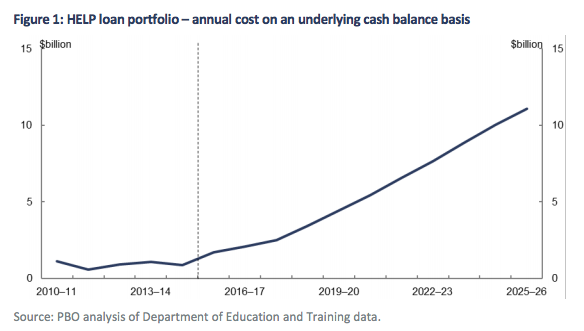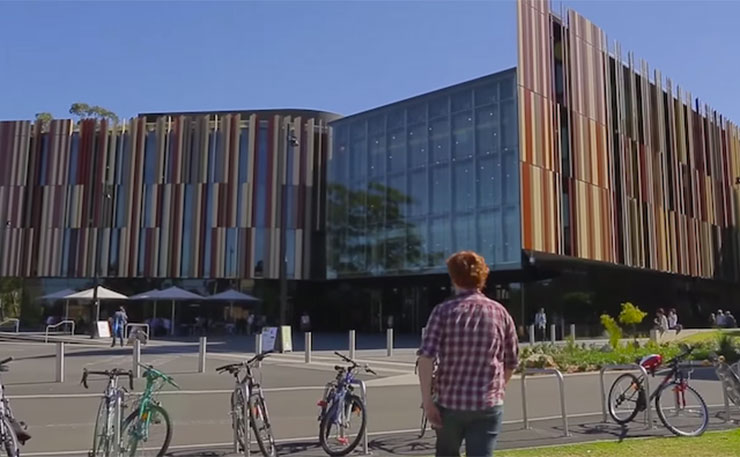The government looks set to forge ahead with university deregulation, a move that will allow fees to skyrocket. If Turnbull wants a real boom he should stop plagiarising his ideas from Tony Abbott’s failed agenda, writes Ben Eltham.
“Higher education loan fiasco sets $185bn time bomb,” screamed the headline in The Australian this morning. Similar reports have run in other media outlets.
The hair-raising figure comes from a new report by the Parliamentary Budget Office, which forecasts that government HECS and HELP debt racked up funding tertiary education will blow out in coming years.
As The Oz’s David Crowe and David Uren wrote this morning, “the stark warning from federal parliament’s independent budget office reveals the true cost of grand promises from Labor and the Coalition in recent years, when they opened the doors to hundreds of thousands of additional students while also encouraging a big rise in fees.”
The PBO report is certainly arresting. It details some genuine fiscal challenges for the federal budget in coming years, particularly from students and graduates that fail to pay back their government higher education loans.
A decade from now, the cost of unpaid HECS and HELP debts will balloon to more than $11 billion a year. Needless to say, this will place huge pressure on future governments to wind back university funding.

But if you delve into the report, the truly shocking fact is not the headline figure of $185 billion. It’s that this problem is almost entirely of the government’s making.
What’s causing the blow-out in future higher education liabilities?
Three things, basically.
Firstly, the Gillard government radically expanded Australian higher education. It did this by “uncapping” the number of undergraduate places in Australian universities.
Before 2009, Australian universities had a hard limit on the number of places they could offer students. This kept a lid on costs, but meant that many young Australians were unable to go to university.
In the wake of the Bradley Review of higher education, Rudd and Gillard removed the caps on student places. The goal was to increase the proportion of Australia’s population with university degrees. So the government allowed vice-chancellors to enrol as many students as they liked. And boy, did they respond! University admissions rapidly climbed, while standards dropped. It is now possible for essentially anyone at all to go to university in Australia.
This means there will be more future graduates in Australia – a good thing – but also more workers paying off their university debts. Inevitably, some will not pay it all off. They may die. They may leave the workforce due to sickness or to care for a family. Or they may simply not earn enough to reach the repayment threshold, currently set at around $54,000.
Secondly, the Gillard government also opened up higher education loans to the vocational sector. This has been an unmitigated disaster. With apparently little in the way of oversight and regulation, a slew of dodgy training colleges set themselves up to fleece hapless students and the Commonwealth of hundreds of millions of dollars. Many of these loans will never be repaid, as they were for courses that weren’t worth the paper their diplomas were printed on.
The slow-moving train wreck of the VET sector never seems to end. We’ve chronicled it repeatedly here at New Matilda, but still the wreckage piles up. Just last month yet another training college folded, as Australian Careers Network went into voluntary administration. 15,000 students were left in the lurch. The cost of the out-of-control sector to the Commonwealth is blowing past $4 billion. Much of that money will never be repaid.
Thirdly, and most importantly, the loan repayments blow-out is being driven by university fee deregulation.
Parents and students breathed a sigh of relief in September last year, when Malcolm Turnbull’s new Education Minister Simon Birmingham announced that the Coalition’s plans to deregulate university fees were being put on hold.
But the plan was never shelved, and now it appears $100,000 university degrees are back on the table. This week, Birmingham told Sky News that the government was still committed to its plan to cut university funding by 20 per cent, and let universities make up the difference by charging students whatever they want. University of Sydney students responded with a protest that resulted in the riot police being called out, demonstrating the strength of ill-feeling felt by students towards the proposal.
The PBO analysis confirms that fee deregulation is still the Coalition’s plan. In the methodology section of the report, it states that:
It is assumed that universities will immediately increase student fees from 2017 to fully recoup the lost revenue from reduced subsidies under the Commonwealth Grant Scheme.
It is likely that that in a deregulated market, universities will further increase fees. The PBO has used an indicative assumption that universities will increase student fees by 2 per cent each year in real terms from 2018, over and above recouping cuts in the Commonwealth Grant scheme.
And there you have it. The government’s plan is to slash funding to universities, forcing them to slug students tens of thousands of dollars extra for their university courses.
Indeed, you could even argue that the PBO’s fee inflation assumptions seem unrealistically low. The prestigious “Group of Eight” sandstone universities will surely increase their fees at well above the rate of inflation. Top private schools are raising their fees at rates of 4, 5 and 6 per cent a year. There’s no reason why the top-ranked unis won’t do the same thing. In a deregulated marketplace, they’d be foolish not to.
It is university fee deregulation, and the surge in university fees it will cause, that is the real cause of the PBO’s predictions for a blow out in unpaid university loans. According to the PBO’s report, “the main driver of the cost of HELP is the assumption that universities will pass through cuts in subsidies under the Commonwealth Grants Scheme to students.”
You can see where this is heading: yet more pain for parents, students and graduates. With the right-wing media screaming about the coming surge in unpaid student debt, it will be all too tempting for the government to take up the Grattan Institute’s recent suggestion to lower the repayment threshold for paying back university debts.
The Grattan Institute’s Andrew Norton wants the threshold lowered from its current figure of $54,000 to $42,000. He justifies this on the grounds that “the subsidies built into HELP loans would be more targeted toward people facing real financial hardship.” Better targeting, of course, is simply a euphemism for making poorer students pay. The Grattan proposal move is regressive, punishing graduates only just getting by and forcing university repayments down onto the lower-middle class. With their lower average earnings, such a “reform” will hit women particularly hard.
You would have thought that making university much more expensive would be the last thing a government championing an “ideas boom” would want to do. You would also have thought that Malcolm Turnbull would run a mile from a policy as manifestly unpopular as $100,000 degrees.
But that’s Malcolm Turnbull’s government for you: every passing day shows it really is just the Abbott government with a different front-bench.
Donate To New Matilda
New Matilda is a small, independent media outlet. We survive through reader contributions, and never losing a lawsuit. If you got something from this article, giving something back helps us to continue speaking truth to power. Every little bit counts.





